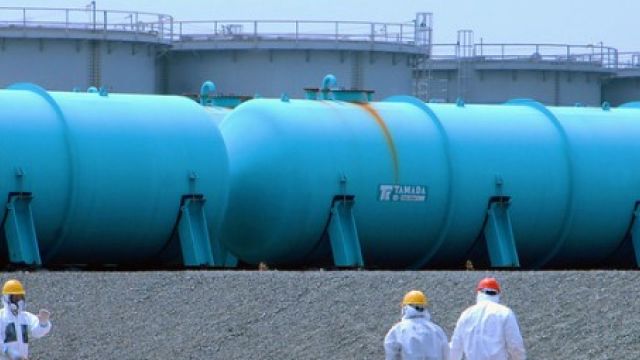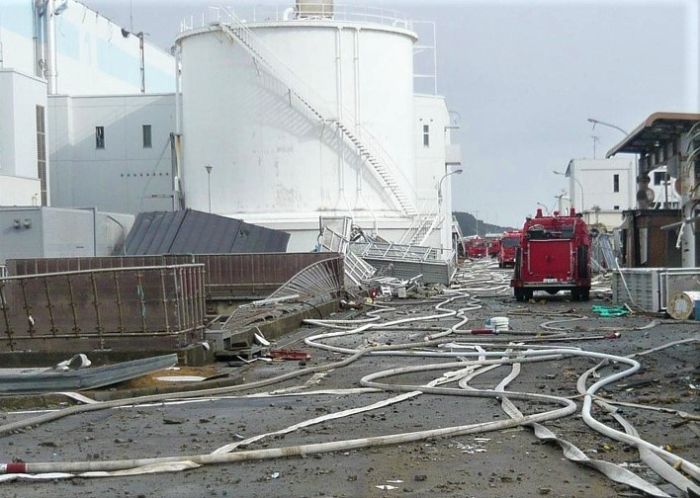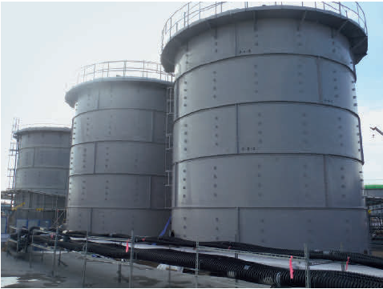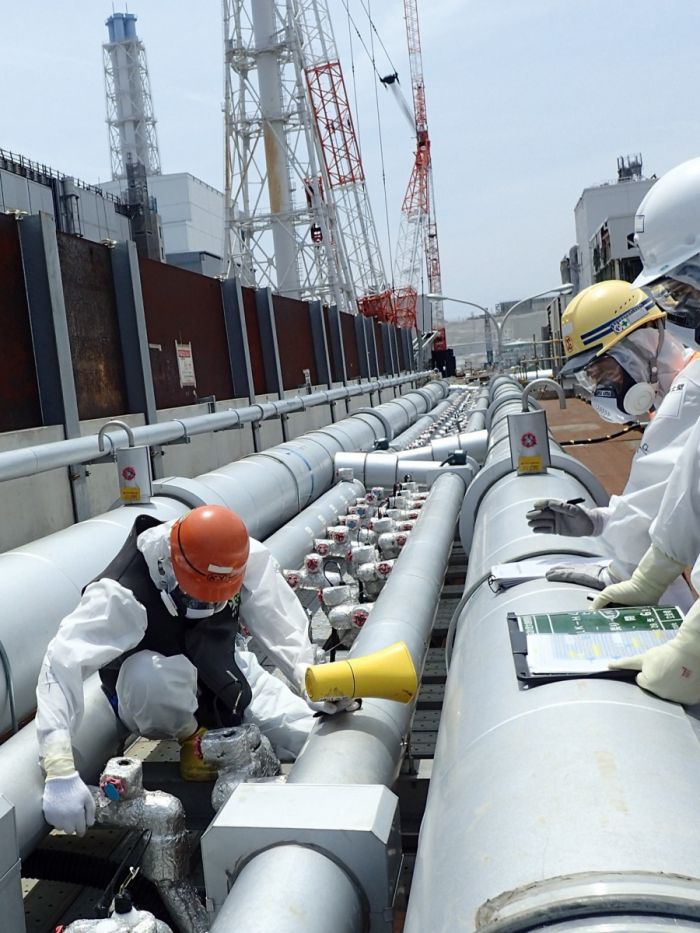
10 Years of Fukushima Part 4: The Water
First priority: Cooling of the reactors
After the earthquake and, above all, the subsequent tsunami in the early morning (German time) of 11 March 2011 had caused a complete power failure and widespread destruction in the plants, there was only one goal for the plant personnel: The cooling of the reactors had to be restored - initially to prevent the reactor cores from melting and later to minimise or completely stop the core meltdown that had already started and the resulting releases of radioactive materials into the environment. In the morning of 12 March, emergency workers managed for the first time to feed water into the reactor of Unit 1 from the outside, using firefighting pumps. At Units 2 and 3, which unlike Unit 4 were also in operation at the time of the earthquake, this was also achieved on the following two days.

Since then, water has been continuously pumped into the destroyed reactors to this day. In the first months and years, the main purpose of this was to prevent the nuclear fuel from heating up again and, as a result, to prevent further core damage. In addition, the water is also intended to ensure that the strong gamma radiation emitted by the highly radioactive nuclear material is shielded. In the meantime, it has been possible to reduce the amount of water pumped in daily because the decay rate naturally decreases over time. In the first few months after the accident, up to 750 tonnes of water were pumped into Units 1 to 3 every day; now it is just over 200 tonnes per day.
The meltdown of the cores could be stopped by pumping water into the reactors. However, it was now the water itself that allowed large quantities of radioactive substances to escape from the reactors. On its way through the reactor pressure vessels and the reactor buildings, it absorbed so-called fissile materials. These are radionuclides such as iodine-131, caesium-137 and strontium-90, which are produced during nuclear fission in the nuclear fuel. The contaminated water enters the adjacent turbine buildings through existing pipelines and cable ducts. In the process, it mixes with groundwater that enters the buildings and channels from the outside, so that the amount of contaminated water increases continuously.
Large releases into the Pacific
By the beginning of April 2011, around 60,000 tonnes of heavily contaminated water had accumulated in the basements of the buildings and in the adjoining sewers. From there, the water leaked from pipe shafts, maintenance tunnels and buildings into the surrounding soil and the ocean. On the one hand, this led to a further increase in the local dose rate on the surrounding terrain, which made the work even more difficult; on the other hand, larger quantities of radionuclides (especially iodine-131 and caesium-137) entered the sea in an uncontrolled manner. As a result, there was a massive increase in the corresponding nuclide concentrations in the seawater, especially in the area of the harbour basin; in some cases, measurements showed that the legal limits were exceeded by up to a thousand times.
To prevent further uncontrolled releases, TEPCO first pumped around 10,000 tonnes of less contaminated water from the waste storage facility's existing tanks into the Pacific Ocean with the approval of the regulatory authority, and then stored the water pumped out of the turbine buildings in these tanks. Work was also begun on the construction of additional tanks. These are tanks with a volume of up to 1,000 tonnes that consist of bolted segments. This tank variant was chosen because it can be erected in a shorter time than welded tanks. The time saving was relevant for two reasons: On the one hand, storage capacities for the amount of contaminated water, which was increasing daily, had to be created as quickly as possible; on the other hand, because of the still high local dose rates on the plant site, those working on the construction of the tanks could only work on site for a short time in order to comply with the legal dose limits.
In the months and years that followed, however, there were repeated releases of contaminated water into the Pacific. A large part of it entered the groundwater and further into the sea through a large number of already existing building penetrations and leaks. Thus, until the mid-2010s, groundwater samples taken on the site between the turbine buildings and the harbour basin sometimes showed significantly elevated radionuclide concentrations. In addition, however, there were repeated leaks from storage tanks or the connected pipe systems until 2014. Because of these leaks and in view of the lower stability during earthquakes, TEPCO decided at the beginning of 2014 to replace the bolted tanks with welded tanks. The transfer of water to the welded tanks was completed in March 2019.
According to the United Nations Scientific Committee on the Effects of Atomic Radiation (UNSCEAR), a total of 10% (for iodine-131) and 50% (for caesium-137) of the amount released into the atmosphere during the accident was released into the Pacific Ocean. According to the International Atomic Energy Agency (IAEA), this is the largest release of radionuclides into an ocean caused by an accident.

Sealing and pumping out
In order to reduce the new quantities of contaminated water produced every day and to prevent it from escaping into the groundwater or the Pacific Ocean as far as possible, TEPCO took various measures from April 2011. Initially, floating barriers made of non-woven fabrics were erected at various points in the harbour basin to prevent contaminated sediments from the cooling water intakes from entering the harbour basin or the open sea. Construction of an impermeable barrier at the quay wall of the harbour basin began in April 2012. Until its completion in autumn 2015, almost 600 steel pipes with a diameter of about one metre and a length of 30 metres were driven almost 20 metres deep into the seabed along the quay wall and then sealed against each other. As a result, a rise in the groundwater level on the one hand and a significant drop in nuclide concentrations in the harbour basin on the other could be measured.
At the same time, the reactor buildings were sealed at various points. This included backfilling the pipeline tunnels and adjoining shafts between the turbine buildings and the harbour basin with special, particularly free-flowing cement mixtures. Previously, attempts to freeze the water that had accumulated in the shafts and thus prevent further water leakage through a kind of "ice plug" had failed.
On the other hand, the fact that groundwater penetrates into the basements of the reactor and turbine buildings is basically intentional: The fact that the groundwater level outside the buildings is higher than the water level inside them prevents uncontrolled leakage of contaminated water from the buildings. However, in order to reduce the groundwater inflow and thus the total amount of contaminated water, existing drainage pumps were put back into operation at various locations and - in significantly larger numbers - new ones were installed. With the so-called Groundwater Bypass, up to 700 tonnes of groundwater which flows towards the plant from a hill is pumped off the side of the buildings facing away from the sea every day. This water is temporarily stored, examined for contamination, cleaned if necessary, and then discharged into the sea after appropriate clearance. The flow rate is limited so that the groundwater level outside the buildings remains higher than the water level inside them. Groundwater is also pumped out from between the buildings and the harbour basin. Because of the concentration of radionuclides it contains, this water is not discharged into the Pacific, but, like the water pumped out of the buildings, is first stored in tanks.
By far the most extensive and complex measure to minimise the inflow of groundwater and thus the accumulation of contaminated water was the construction of the so-called "ice wall" (also referred to by TEPCO as the "land-side impermeable wall" or "frozen soil wall"). This is an approximately 1,500-metre-long and several-metre-deep barrier made of frozen soil that surrounds reactor Units 1 to 4 and is intended to significantly reduce the inflow and outflow of groundwater. From mid-2014 to early 2016, boreholes were drilled into the ground to a depth of 30 metres at intervals of around one metre to construct the barrier. In these more than 1500 boreholes, freezing pipes were installed through which a brine solution cooled down to -30 °C was fed. This procedure was already known and proven in civil engineering. The ice wall is said to be designed to withstand even an earthquake.
In connection with the reduction of the amount of water fed into the reactors of Units 1 to 3 every day, the above-mentioned measures made it possible to significantly reduce the amount of contaminated water produced every day, according to TEPCO. TEPCO says that the amount that has to be additionally stored in tanks every day fell from around 450 to 500 tonnes (by the end of 2014) to around 150 tonnes today.

Treatment of the contaminated water
In parallel with the erection of tanks for the storage of the contaminated water, TEPCO already had facilities built in the first few months to remove radionuclides from the water in addition to salt and other residues such as oil. One of the main reasons for this was that the steadily increasing number of filled tanks caused additional radiation exposure for the personnel working in their vicinity. By reducing the nuclide concentrations in the water, that exposure was lessened. At the same time, part of the treated water was reused for cooling the reactors in order to keep the total amount of water produced as low as possible through a quasi-closed circuit.
From mid-2011 to autumn 2014, several different facilities were constructed or expanded. Two of them are used to remove caesium and strontium from the water. Three others ("ALPS") also remove 60 other radionuclides from the water. According to TEPCO, the effectiveness of the facilities is very high: Depending on the nuclide, the nuclide concentrations can be reduced to one hundredth or up to one thousandth of the initial value. However, TEPCO's goal of purifying the water to such an extent that the nuclide-specific limits are met has so far only been achieved for about a quarter of the total volume of stored water.
All water also still contains radioactive tritium. As an isotope of hydrogen, it is a component of the water molecules and thus cannot be removed by common water treatment processes. Although it is possible in principle to separate it using complex processes on a laboratory scale, a programme sponsored by the Japanese government in which various foreign companies were to demonstrate feasibility on an industrial scale ended without any useful results.
Where to put the water?
To date, a total of around 1.25 million tonnes (as at February 2021) of contaminated water has accumulated. The daily rise also increases the need for tank capacities and, associated with this, for corresponding areas on the plant site where further tanks can be built. Since according to TEPCO the maximum available tank capacities of around 1.37 million tonnes are expected to be exhausted in the summer of 2022, a commission of experts appointed by the Japanese government has been investigating in recent years whether and, if so, how the water can be disposed of.
The investigations, whose results were published in April 2020, focused on two options: One, in simplified terms, provides for evaporation of the water with release of the tritium-containing vapour into the atmosphere; the second consists of discharge into the Pacific Ocean. The prerequisite for both variants is that the remaining radionuclides, which are still present in about 75 % of the total amount in concentrations above the limit values, are removed by renewed treatment to such an extent that the limits are not exceeded. Other options, such as discharge into the subsoil in liquid or solidified form, were already discarded at an earlier stage because, in the commission's view, they would be fraught with too many as yet unresolved technical issues and would require considerably more time.
For the two remaining options, the maximum dose exposures for the population and the maximum concentrations of tritium in seawater to be expected under conservative assumptions were estimated. With reference to the results, TEPCO and the Japanese government favour a discharge into the sea. In the commission's view, this is associated with a lower additional dose exposure compared to evaporation; an additional dose of about 0.0008 millisievert per year is expected here (for comparison: the natural annual radiation exposure in Japan and Germany is about 2.1 millisievert).
Despite these assessments, the project is highly controversial. Fishermen from the affected region, for example, fear that their catch products would no longer be marketable in the event of a discharge. Concerns have also been expressed by neighbouring countries such as Korea and China and by various non-governmental organisations in Germany and abroad. In contrast, there is widespread agreement among experts that a discharge of water in the planned form would not lead to any relevant radiological consequences for humans and the environment. The reasons for this are, on the one hand, the specific physical and radiobiological properties of tritium and the large dilution effect (see also the Interview with Dr. Thorsten Stahl, Head of the Radiation and Environmental Protection Department at GRS). On the other hand, the total amount of tritium is in the range of what is discharged in a year in some nuclear facilities around the world with the appropriate authorisation. If all the water containing tritium were discharged into the Pacific Ocean over ten years, according to calculations by the Federal Office for Radiation Protection, the annual amount of tritium would roughly correspond to the annual discharge of tritium with the wastewater from all German nuclear power plants in 2016.
As things stand, a final decision on a discharge has not yet been made. Once a decision has been taken, a licensing procedure will first have to be carried out. Due to further technical preparations, the Japanese government has stated that it may not be possible to start discharging for at least two years.
Please have a look at "Part 1: Accident sequence - Milestones of a disaster", "Part 2: Radiological Consequences" and "Part 3: Dismantling" of our series "10 Years of Fukushima" as well.
Find out more
BfS: Umweltfolgen des Unfalls von Fukushima: Die radiologische Situation in Japan
METI: The Subcommittee on Handling of the ALPS Treated Water Report (April 2020)